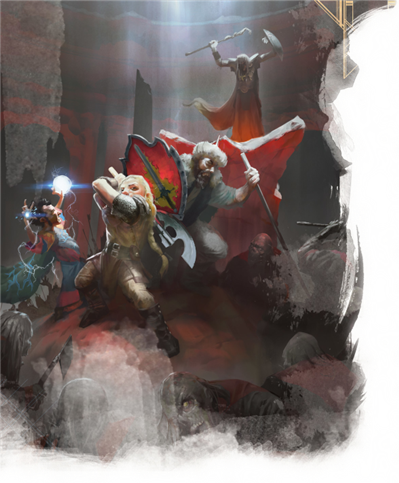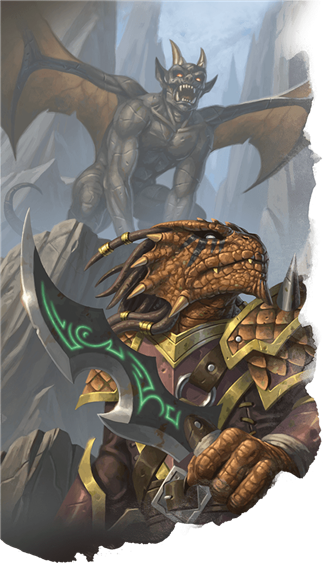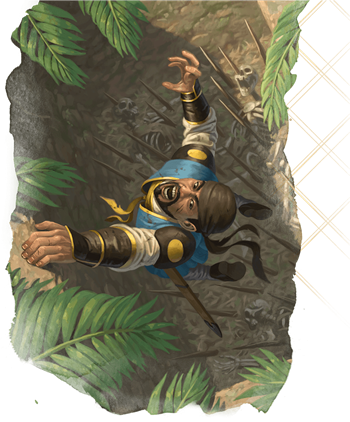 There’s been an influx of D&D players in the last few years, largely due to the streamlined ruleset of fifth edition and the explosion of livestreamed campaigns like Critical Role. Dungeons and Dragons has become bigger than it’s ever been before, and no individual gaming group plays the game in the exact same way, or for the exact same reasons. Some revel in the bloody throes of combat, hacking and slashing with slick, shining swords or methodical, mischievous magic. Others take pleasure in the fantasy of living in a world of magic and heroes by interacting socially with characters and creatures they dreamt of as children. These two foundations of the game harmonize with one another, but only when the Dungeon Master knows how best to manifest the mixture. The first tip I’ll be sharing with you, as we focus in on the methods of management, is how to make combat have a stronger narrative presence in your campaign.
There’s been an influx of D&D players in the last few years, largely due to the streamlined ruleset of fifth edition and the explosion of livestreamed campaigns like Critical Role. Dungeons and Dragons has become bigger than it’s ever been before, and no individual gaming group plays the game in the exact same way, or for the exact same reasons. Some revel in the bloody throes of combat, hacking and slashing with slick, shining swords or methodical, mischievous magic. Others take pleasure in the fantasy of living in a world of magic and heroes by interacting socially with characters and creatures they dreamt of as children. These two foundations of the game harmonize with one another, but only when the Dungeon Master knows how best to manifest the mixture. The first tip I’ll be sharing with you, as we focus in on the methods of management, is how to make combat have a stronger narrative presence in your campaign.
Combat is important in D&D; it’s the time at which most players get to use their most exciting class abilities. Barbarians unleash their Rage with a gore-covered axe held high, and rogues meticulously maneuver into the perfect position for a silent assassination. But there are those who find the long hours—or even short minutes—of combat to be disconnected from the session’s journey. Things don't have to be this way. The best D&D games interweave narrative depth into combat encounters and mechanical interest into roleplaying scenes, engaging all types of players in all types of scenes. These tips are simple, but their value is deep. Intertwine everything.
The Devil in the Details
Aesthetic can function for more than just atmosphere. In the best stories, the details carry clues and mysteries to be hunted and unraveled. In your overarching narrative, your grand enemy prowls the land clad in armor of deep crimsons and ghoulish blacks. These colors can become signifiers of allegiance to this creature, or to go further, the opposite palate may signify opposition to this evil. This isn’t an uncommon use of visual storytelling. It’s the method of use, however, that ties our mysterious plot hook into battle. Good stories, be they novels, films, or D&D campaigns, don't give you any information that isn’t in someway relevant to the narrative. The description of a messy kitchen depicts how often a character cooks, and how little they care for cleaning. It may lend to how many people live in the household, and how many of them are in the care of the chef. All of these factors tell us about the life of our cook before we even meet the character. Combat scenarios can have the same effect in lending detail and intrigue, especially when long turns and poor rolls can lead to disinterest.
The mathematics of mechanical success and failure are at the will of the dice. As a Dungeon Master, you’ll see how these fluctuations affect the morale of the players at your table. Even a successful attack may not be what a player finds value in. This is an opportunity, rather than a potential dead end. For instance:
Your warlock’s eldritch blast tears through the air, directly at the chest of the heavily armored knight. Your magic strikes with an unholy ferocity, successfully dealing 14 damage to your opponent. As the knight recovers from the blow, you see beneath their crimson and black tunic another garment of green and white.
Even if the players haven’t encountered these colors, which are in contrast of the colors of their grand enemy, you’ve now given them a clue to invest in. You can directly recommend and challenge your narrative-focused players to pursue the clue with ability checks and dialogue. Invest time in aligning details from non-combat situations into your battles and your table will have a great deal of detective work laid out before them.
Not Just Kills, Thrills
 Many players—especially those who cut their gaming teeth on video games or hack-'n-slash dungeon crawls—will slay just about every enemy you place in front of them unless you show them that murder isn’t the only way to achieve their goals. A great deal of what you’re doing in D&D is detective work. If we use that frame in the context of combat, it becomes a place where your gumshoes gain major advantages in their quest for information.
Many players—especially those who cut their gaming teeth on video games or hack-'n-slash dungeon crawls—will slay just about every enemy you place in front of them unless you show them that murder isn’t the only way to achieve their goals. A great deal of what you’re doing in D&D is detective work. If we use that frame in the context of combat, it becomes a place where your gumshoes gain major advantages in their quest for information.
When your party comes close to claiming victory over their enemies, they then have an opportunity to leverage the situation to gain information. A bandit loses loyalty to their troupe as their numbers thin, leaving your heroes with a chance to take a prisoner. A cultist sorcerer deems their life more valuable than their faith and shows you a secret passage to their leader. It’s even possible that a powerful opponent finds respect in their enemy as you lock swords with them, granting knowledge upon receiving an honorable loss. Morale plays a huge role in real-life combat scenarios. You can try to represent morale with a mechanical framework (past editions of D&D have done so!) or simply through DM fiat.
In short, create conditions that are only obtainable through analyzing the potential benefits of capture, surrender, intimidation, and trickery. And on that point...
Enemies Speak!
It’s in moments of stress and tension that it’s easiest to reveal information that one might otherwise have kept secret. When in a tavern, attempting to goad the location of a kidnapped monarch out of a clever wizard, you might require a character to succeed on a Charisma check with a DC of 20 or higher. When combat is joined and staffs are raised, summoning flame and wind and water from the skies, the DC of the check might drop to 18 or lower. How do the players know that the check has become easier in combat? Give you enemies lines to speak! Show their emotional instability upon being surrounded, upon losing allies to your superior strategy or relentless strength.
Imagine yourself as the enemy of your party. If you’re the vengeful cleric leader of this group out for the blood of the party’s druid, there’s likely a lot you have to say as to why this moment has arrived between you. Lend those moments to your players, specifically to engage with. Speak a few lines and communicate that checks can be made to influence how much information their enemy may provide. Whether that be their personal story or clues about the journey at large, the value of immersion is gained. You can make this system as simple or as complex as you want by considering how conflict-averse or bloodthirsty a foe is, if they've been given strict orders upon pain of death to avoid speaking, and so on. A super simple system is this: if a creature is below half its maximum hit points and conflict-averse, Charisma checks made to get the creature to speak have advantage. If they're prone to violence, then Charisma checks have disadvantage when the creature is below half its hit point maximum.
Ability Checks Are Indeed, Free
 Ability checks are one of the key ways that a character can interact with their environment, even in the midst of a violent confrontation. The rules regarding making ability checks in combat aren't crystal clear. Thus, every DM seems to have their own set of house rules regarding the opportunity cost of a ability check. Some DMs rule that making an ability check in combat requires an action, some decide that you need to use a bonus action to make a check, and others rule that an ability check is free, but can only be done once per turn... and so on. The Player's Handbook doesn't have a hard-and-fast rule for what kind of action you need to make an ability check, preferring to leave it in the hands of the Dungeon Master.
Ability checks are one of the key ways that a character can interact with their environment, even in the midst of a violent confrontation. The rules regarding making ability checks in combat aren't crystal clear. Thus, every DM seems to have their own set of house rules regarding the opportunity cost of a ability check. Some DMs rule that making an ability check in combat requires an action, some decide that you need to use a bonus action to make a check, and others rule that an ability check is free, but can only be done once per turn... and so on. The Player's Handbook doesn't have a hard-and-fast rule for what kind of action you need to make an ability check, preferring to leave it in the hands of the Dungeon Master.
Err on the side of generosity when allowing characters to make ability checks: only a smalls set of very specific checks cost an action in combat. Otherwise, encourage your characters to interact with their environment by making ability checks free of charge. When it comes to engaging in the narrative tools you’ve laid about your combat scenario, players will rarely give up their action for a skill check because the value of actions are incredibly high. There must be an incentive to engage in your story elements, and that is easily given when participation is free. Choosing otherwise is removing one of the strongest tools you have for players to engage in the multifaceted adventure you’ve come to construct.
Lies and Deception
With all of these tools in hand, keep in mind that the opposition can be just as intelligent, clever, or convincing as your heroes, if not more. When a bard’s life is on the line, they may concoct a mixture of partial lies and half-truths in order to live another day. A proud lizardfolk may seemingly give away the location and formation of their troupe, or it may have been the last deed of honor they do for their cohorts. This brings into consideration what kind of opponent the characters are fighting, beyond the stat block. That leads into the specifics of each individual character’s ability check scores, which usually vary to a large degree. If specific players are more interested in these narrative aspects of combat, slightly tilting the required skill checks in their hero’s favor may help them engage further.
And don’t be afraid for your players to be outwitted. For more intelligent and intimidating enemies, there’s the potential for them to use ability checks against the party. For example, you raise an encounter that the players are doomed to lose. A demonstration of how powerless they are, as well as how powerful they must become. Let your villain slyly trick your sorcerer into saying more than they should by rolling insight or intimidation against one another, applying their mighty +10 and resulting in victory. This replicates the loss of sense one has when in great danger, and contrasts the valley of difference between where you’re beginning and where you hope to end. That small loss resonates with players as a trap to avoid while also building the beginnings of a rivalry. Losing a battle of wits can sometimes be more thrilling than losing a battle of blades.
Your Own Play Style
Players of many different play styles and skill sets play D&D, so there’s no one set way to play the game. When a table of players form, the rules, campaign, themes, and even setting, can change dramatically. That’s the beauty of the game. As a Dungeon Master, you have to be aware of the tools you possess to make sessions as fun as possible. A large part of that is communicating with your players and asking them what their needs are. What areas of a session are they most engaged in, and which can be flat out boring? No one creates a perfect campaign right at the get-go. It takes refining over time.
Combat is a place where this refining is much needed, especially as more narrative focused players enter the community. Expanding your skill set to best suit them is key to being the ever-evolving DM. So my final tip is to talk to your players about implementing these tools. If they don’t work for your table, no worries! At the very least, you’ve opened up a space where experimentation and open dialogue is an option. That kind of care for your players keeps them coming back each week.
Speaking of, I’ll be bringing some more of the helpful tips I’ve learned over the years here to D&D Beyond. Stay tuned for my next article, which is going to be on formulating character stories and backgrounds. Let’s investigate how we frame our adventurers before the game begins and how we might angle our heroes in new and interesting ways. Until then and beyond, keep rolling 20s.
Have you ever focused on creating combat encounters that tell a story in D&D? Tell us about it in the comments!
 DC is an independent game designer, and the creator and author of plot ARMOR, as well as a freelance writer for Wizards of the Coast. You can find them assisting the tabletop roleplaying game community’s growth on Twitter @DungeonCommandr.
DC is an independent game designer, and the creator and author of plot ARMOR, as well as a freelance writer for Wizards of the Coast. You can find them assisting the tabletop roleplaying game community’s growth on Twitter @DungeonCommandr.








-
View User Profile
-
Send Message
Posted Aug 7, 2019Great article! I follow you on Patreon, and I'm excited to see your wisdom and voice becoming part of this community. Major bonus for us.
-
View User Profile
-
Send Message
Posted Aug 7, 2019Ahhhh yes. I’ve been needing this article for a good two months now. Combat has consistently ground to a slow trod, and a strong narrative aspect of combat is precisely what it could benefit from. Thanks so much! I look forward to the next article.
-
View User Profile
-
Send Message
Posted Aug 7, 2019A lot of people complain about their players being murder-hobos who kill everything they see. My problem is the opposite. My players never fight unless they have no other choice, which makes it very difficult to run dungeons bigger than a few rooms, because they barter with, befriend, or otherwise circumvent creatures that would normally thirst for blood.
I really like this article. It gives pretty good advice for DMs who haven't figured this all out yet.
-
View User Profile
-
Send Message
Posted Aug 7, 2019Fantastic article. Being open with your players and the tools at their disposal is key. You don't have to follow the handbook, but you should use the hand book to create tools for your players to engage in the game. They don't know what they can do until you build that menu
-
View User Profile
-
Send Message
Posted Aug 7, 2019I often try to be as descriptive as possible when my players get a kill, but it does add length to our encounters. Great Article!
-
View User Profile
-
Send Message
Posted Aug 7, 2019Thank you, great article! While I read the lines- enemies speak, my thoughts goes to my campaign, where in a ghoul boss fight I see on his stat block: language elven. I ask my players, do anyone speak elfish? In the voice of Elvis Presley. And yes mindflayers in my campaign has the voice of Sean Connery.
So good to see more social/ battle tips thanks!
-
View User Profile
-
Send Message
Posted Aug 7, 2019Elvish Presley
-
View User Profile
-
Send Message
Posted Aug 7, 2019In my party's next battle, they will be facing a homebrewed Neothelid. The tadpole it comes from originally was meant for a Dragonborn noble traveling to an allied city to negotiate terms of a trade agreement. Illithids decided that the Dragonborn was a good target for Ceremorphosis. The Dragonborn was waylaid by a trio of trolls, however, and killed before the process was complete. While the trolls slept, the tadpole (now a bit bigger), crawled into one of the Troll's nostrils and attempted Ceremorphosis on it.
The troll was killed the next day by the party, but they didn't burn the body. The tadpole consumed the Troll's brain and then its flesh, growing larger and larger and absorbing some of the elements of the Troll (regeneration, skin texture, and tufts of hair) along the way.
The party's first mission, which resulted in them killing the troll, is now coming full circle to tell the story of an invading army of Illithids and their failed attempt to infiltrate noble society via the Dragonborn. All of this information is conveyed through combat, where they will discover the mutated properties of the Neothelid and the Dragonborn's severed head-minus-brain.
By the way, the Troll Neothelid (Trothelid) is one of my proudest homebrew creations and will eventually be released to the community on here. :)
-
View User Profile
-
Send Message
Posted Aug 7, 2019Like the article stated, some creatures and/or enemies are more prone to violence and therefore charisma checks have disadvantage against them while they are below half health. You can expand and capitalize on this. Some enemies just can't be reasoned with no matter how good you roll. So unless your players are rolling nat 20s left and right then use this to coerce more combat. Like you said if they can avoid it they will. So don't give them that opportunity but don't make it feel forced.
-
View User Profile
-
Send Message
Posted Aug 7, 2019I love using Perception checks to notice things, or Intuition to drive story information into players and noticed players responding to that very, very well!
-
View User Profile
-
Send Message
Posted Aug 7, 2019Thank you! What a wonderful article. Very helpful!
-
View User Profile
-
Send Message
Posted Aug 8, 2019Love this but wished the rules as written XP system wasn't so heavy handed about rewarding murder hobos over roleplaying. I use an alternative system but if D&D wants more than combat they should make none combat just as rewarding in XP n loot drops as combat
-
View User Profile
-
Send Message
Posted Aug 8, 2019If my players find a way to role-play their way thru an encounter with an NPC or monster, I award the XP as if they defeated the encounter.
-
View User Profile
-
Send Message
Posted Aug 8, 2019Great advice!! I've been looking for ways to keep my players interested in combat, and I got some good ideas from this!
-
View User Profile
-
Send Message
Posted Aug 8, 2019Just what i was looking for! Fantastic article! I’ll be running LLoK in a few weeks and this is after a long break as DM! I will definitely be putting these tips to great use!
-
View User Profile
-
Send Message
Posted Aug 8, 2019Good article. I almost never have a combat that doesn't have a meaning to the story, whether that is a clue about what's happening or a reaction to the Party's actions. However, one thing I usually forget to do that you highlight is having enemies speak! You bring up really good points about the value of that interaction in combat and I will have to make an effort to remember to implement that in the future.
-
View User Profile
-
Send Message
Posted Aug 8, 2019Very cool stuff! Thanks for all the advice. I'll definitely have to think about the armor and equipment of my enemies in the game I DM
-
View User Profile
-
Send Message
Posted Aug 8, 2019This was a fantastic article and I will definitely be looking for more! Just started running my own semi-homebrew campaign and it's going well, just find it a small bit mechanical at the moment.
One thing I found i had to do was raise the stakes because they kept on short resting everywhere. So I had one of them kidnapped at night & tortured (losing a little finger). There was never real danger but the characters now know that "holy crap, if we dont have our wits about us we're doomed!"
-
View User Profile
-
Send Message
Posted Aug 8, 2019Use the milestone system.
-
View User Profile
-
Send Message
Posted Aug 8, 2019Good article, but I think one super important piece that I've had to learn over time: don't be afraid to tell them how their characters feel. Remind them of their character traits bonds, and ideals. Especially if you got into this from Critical Role or something similar, chances are really good that your players aren't natural actors or brilliant improvisational performers, so giving them some context of what's going on in their minds can inform the choices they make for the characters.
For example, when an enemy's magic feels weird and alien and insurmountable and you want them to be nervous and unbalanced by that, ask them for an ability check when they fail a saving throw. Regardless of the outcome, then tell them that they feel that way (magic feels alien, weird, insurmountable), regardless of the outcome. If they roll high on the check, then they will interpret this as a unique insight that they've gleaned. If they low ball the roll, they'll be like "oh no, there's something to learn here and I don't know it," which will change the way the players play.
Your players don't know whats scary or impressive or normal or weird for your world. Give them context by telling them what their characters are feeling every now and again. As the game evolves and your players grown in skill, the need for this will decrease.